Thursday, August 09, 2007
Check out my New Site
Hello Everyone who visits my blog. I just decided to start a new blog with a little more focus than this one. I feel that my posts were to varied on this site. Please check out my new WordPress site "Dialogues with Silence" where I will be posting more frequently.
Wednesday, July 11, 2007
Official Charity - FIFA U-20 World Cup
I've had a very exciting opportunity this summer to work for the official Charity of the FIFA U-20 World Cup. I have been working as the contact in Edmonton to organize volunteers, as the main office of the Charity is in Ottawa. FIFA has given us a great platform to raise awareness about SOS Children's Villages. We're raising money for a Village in Namibia for orphaned and abandoned children. These villages have about 10 houses and about 7 orphaned children in each house. The villages provide more of a family life than an orphanage could - as there is a mother who lives with children in each house as they grow up. Being an SOS mother is a very large commitment and they have my utmost respect. In the villages there is also medical attention on site, a kindergarten, vocational training and social programs. FIFA even provides Soccer pitches, so that the kids can develop self esteem and have fun.

Here is my very enthusiastic volunteer team (only part of it!). We've been face painting like crazy to attract people to our tent so that we can tell them more about the village we're raising money for. Today we started selling raffle tickets to raise money for the village. It's been going really well and I've been having so much fun with all these great people. There is a bit of stress with all of the logistics of setting up the tent and FIFA regulations, but it's worth it and I'm so glad for the experience of working for an NPO as it's what I'd like to do once I graduate from University.

A few of my volunteers and I were lucky enough to get VIP tickets to the first game. here we are at our table overlooking the Commonwealth Stadium. The stadium is so huge that the Edmonton Eskimos haven't even sold it out. Normally, soccer tournaments are at stadiums that seat 20 000, but this stadium seats 40 000!!
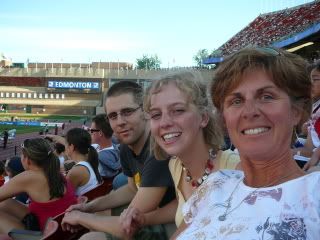
Zak's mom even made it out to one of the games. Here's me, Zak, and Becky in the stands.

Here is my very enthusiastic volunteer team (only part of it!). We've been face painting like crazy to attract people to our tent so that we can tell them more about the village we're raising money for. Today we started selling raffle tickets to raise money for the village. It's been going really well and I've been having so much fun with all these great people. There is a bit of stress with all of the logistics of setting up the tent and FIFA regulations, but it's worth it and I'm so glad for the experience of working for an NPO as it's what I'd like to do once I graduate from University.

A few of my volunteers and I were lucky enough to get VIP tickets to the first game. here we are at our table overlooking the Commonwealth Stadium. The stadium is so huge that the Edmonton Eskimos haven't even sold it out. Normally, soccer tournaments are at stadiums that seat 20 000, but this stadium seats 40 000!!

Zak's mom even made it out to one of the games. Here's me, Zak, and Becky in the stands.
Saturday, June 30, 2007
Made for you

It has been a very enjoyable afternoon of making necklaces while listening to Jazz music. I have begun my necklace selling business and I've been working on an order of five necklaces. I'd like to share the necklaces with you. You can order similar ones or the same ones - I will make a necklace especially for you or for your special someone. This necklace above is $18 Canadian. The average price of my necklaces is $15-$35. I like to use semi-precious stones or vibrant colours as seen above.

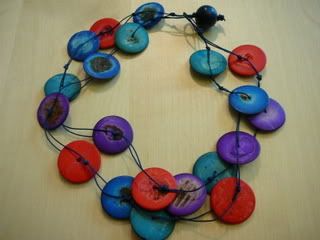
This one is made of wooden circular beads and waxed cord. The clasp is made of a round wooden bead and the waxed cord loops around it. This is my personal favourite. The next one I make will have to be for me:) Unfortunately, I'm selling this one, but I can made many more for you (and me:)

Let me know which ones you like, or send me a picture of an outfit or shirt that you're trying to find a necklace for. If you don't know exactly what you want, I will be posting more of my necklaces online as I make them.
Here is another necklace that I made this afternoon. It is made of Cherry Quartz and mother of pearl. This one is $32 Cdn.
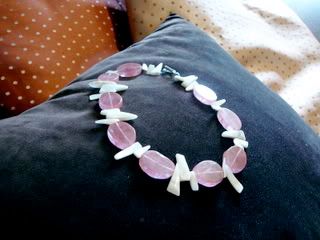
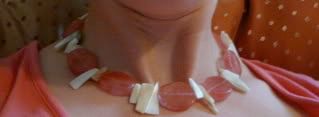


I love to sit here and work in the living room. I can hear the birds chirping outside and the sound of the wind through the trees and our overgrown bushes. The sky has changed so many times this afternoon. First it was sunny, and then it got really windy and looked like another storm was going to come. The sky was overcast and looked as though it was fully of rain. It did not come and now it's sunny again. I think it's time to take a break from my necklaces and play some bocce ball!
Please leave a comment if you would like a particular necklace. The cost is minimal if you would like it mailed to you. I mailed one from Edmonton, to Delhi, ON and it only cost $1.25. I will be setting up a paypal account if there is enough interest. For now, you can send me a money order or a personal cheque if I know you well. You can contact me at aldyck (at) ualberta (dot) ca if you would like one made for you!
Thursday, June 21, 2007
Footsteps on the Roof

I'm sitting here in the dark. Out my large window are flashes of light. They are still far away. I enjoy the peaceful wind that blows through the trees that brings with it a soft rain. My doors and windows are open and the sounds of the incoming storm bring me a sense of peace. I close my eyes and let the sounds fill me. Wait - is that someone at my door? What has interrupted my calm? It sounds like footsteps on the roof. They patter and seem to be joining me in my house. Now there seems to be a whole crowd. It gets more and more intense. I close the door and shut the window, but the sounds are still persistent. I invite the sounds in. I cannot sleep now - I have guests.
Saturday, June 16, 2007
Journaling
"Meanwhile, I am becoming more and more aware that for me writing is a very powerful way of concentrating and of clarifying for myself many thoughts and feelings. Once I put pen on paper and write for an hour or two, a real sense of peace and harmony comes to me . . . After a day without any writing . . . I often have a general feeling of mental constipation and go to bed with a sense that I did not do what I should have done that day." - Henri Nouwen, The Genesse Diary

I have been journaling for just over three years now. It all began with a journal that I got from Zak's Mom, the Christmas after we started dating. That journal started a journey into understanding myself. After I spend a while writing I find that I have clarity. If I start my day off journaling, I am in a much better mood and I go about my day with purpose. When I write I realize what is important to me.
The picture above is of the second journal that I got from Zak's parents. It is a beautiful handmade journal that they brought back from their trip to Italy. I have two journals right now and I save this one for special occasions - it is my travel journal. It is nice and small and durable. I can bring it anywhere with me and not worry about being weighed down. When I take it on a trip, the smell of it is fresh each time. It feels like a treat to be able to write in it. It is an adventure when I sit down to write - being in a new place and understanding myself in relation to that new place.

My most recent trip was to Jasper National Park. I went with a number of friends and we were able to stay in the group camping area which was a beautiful meadow that was surrounded by views of the mountains. Immediately around the meadow was the cottonwood and evergreen forest. I liked to take note that the evergreens were mostly in separate pockets from the cottonwood trees. I found my journaling spot amongst the cottonwoods and sat on the stump that is pictured above.

I have been journaling for just over three years now. It all began with a journal that I got from Zak's Mom, the Christmas after we started dating. That journal started a journey into understanding myself. After I spend a while writing I find that I have clarity. If I start my day off journaling, I am in a much better mood and I go about my day with purpose. When I write I realize what is important to me.
The picture above is of the second journal that I got from Zak's parents. It is a beautiful handmade journal that they brought back from their trip to Italy. I have two journals right now and I save this one for special occasions - it is my travel journal. It is nice and small and durable. I can bring it anywhere with me and not worry about being weighed down. When I take it on a trip, the smell of it is fresh each time. It feels like a treat to be able to write in it. It is an adventure when I sit down to write - being in a new place and understanding myself in relation to that new place.

My most recent trip was to Jasper National Park. I went with a number of friends and we were able to stay in the group camping area which was a beautiful meadow that was surrounded by views of the mountains. Immediately around the meadow was the cottonwood and evergreen forest. I liked to take note that the evergreens were mostly in separate pockets from the cottonwood trees. I found my journaling spot amongst the cottonwoods and sat on the stump that is pictured above.
Monday, May 28, 2007
Water
"Many of us who have lived most of our lives in the industrialized countries of the North may find it difficult to imagine running out of water. We have lived with steady supplies most of our lives and have used it lavishly. But at current rates of use, we will run short." - Maude Barlow, Blue Gold
Right after I heard this author speak at International Week at the University of Alberta, I bought the book that this quote is from. There was a very interesting panel that was put together to discuss a very important issue of our day - water and the way that we use it.
First in the panel there was the President of the Syncrude Oil company in Alberta. He discussed the many different ways that his company works to reduce the amount of water that is used to extract oil from the tar sands. Despite the reduction techniques of reusing the water many times for cooling, there is still a massive amount of water that is used by the oil industry. As the different members of the panel presented their opinions and relationship with water, you could feel a resentment for the oil industry becoming very strong. Most of this resentment was directed at the President of the Oil company. In the question period at the end of the presentations by the four representatives, there were many harsh questions directed at Syncrude. One member of the audience aptly pointed out that the resentment and anger was wrongly directed, because we as a society create the demand for all this oil. There are many desires that we have as a consumerist society that contribute to the rapid depletion of fresh water sources.
Another member of the panel was a professor from the University of Alberta. For many years he has been doing research on the water levels in the Alberta area. He presented his findings that the glacier that flows into the Bow River is melting at an alarming rate and it is the key source of fresh water for the Calgary area.
The third member of the panel was a UofA Business graduate who wanted to start a company that was socially responsible. He began a water bottling company called Earth Water that donates a good portion of the proceeds to the United Nations Refugee Fund.
Maude Barlow also spoke in this panel and presented the basic ideas of her book Blue Gold. She described the many cases of pollution of surface water and the use of ground water at rates that are faster than the water is replenished. What inspired me most was the use of stories of her travels to various third world countries that are harshly affected by a shortage of water.
In North America, we may not yet notice the consequence of our lavish use of water. In Canada there is seemingly and endless supply of water. What we aren't noticing is the problems that have been occurring in developing countries for quite some time already. Countries like Mexico, particularly in the urban areas, have almost completely used up their ground water supply, and it can no longer be replenished. Now that there is no water in the aquifer that lies beneath the ground, the city is sinking at a rapid rate.
Many of the poor people in the slums are not able to pay to have water delivered to their houses. They also cannot afford running water or pipes into their houses to deliver municipal water. Many of the rich people in poor countries can afford pipes and they are paying much less to have municipal water delivered to their houses rather than the high delivery price that the poor people must pay. Water is a basic human right, and many poor people cannot afford it.
This then leads to the discussion on the commodification of water. If water is a basic human right - then why isn't it accessible to all and why is the private sector gaining so much control over it? Why do we as North Americans feel the need to have water bottled?
Right after I heard this author speak at International Week at the University of Alberta, I bought the book that this quote is from. There was a very interesting panel that was put together to discuss a very important issue of our day - water and the way that we use it.
First in the panel there was the President of the Syncrude Oil company in Alberta. He discussed the many different ways that his company works to reduce the amount of water that is used to extract oil from the tar sands. Despite the reduction techniques of reusing the water many times for cooling, there is still a massive amount of water that is used by the oil industry. As the different members of the panel presented their opinions and relationship with water, you could feel a resentment for the oil industry becoming very strong. Most of this resentment was directed at the President of the Oil company. In the question period at the end of the presentations by the four representatives, there were many harsh questions directed at Syncrude. One member of the audience aptly pointed out that the resentment and anger was wrongly directed, because we as a society create the demand for all this oil. There are many desires that we have as a consumerist society that contribute to the rapid depletion of fresh water sources.
Another member of the panel was a professor from the University of Alberta. For many years he has been doing research on the water levels in the Alberta area. He presented his findings that the glacier that flows into the Bow River is melting at an alarming rate and it is the key source of fresh water for the Calgary area.
The third member of the panel was a UofA Business graduate who wanted to start a company that was socially responsible. He began a water bottling company called Earth Water that donates a good portion of the proceeds to the United Nations Refugee Fund.
Maude Barlow also spoke in this panel and presented the basic ideas of her book Blue Gold. She described the many cases of pollution of surface water and the use of ground water at rates that are faster than the water is replenished. What inspired me most was the use of stories of her travels to various third world countries that are harshly affected by a shortage of water.
In North America, we may not yet notice the consequence of our lavish use of water. In Canada there is seemingly and endless supply of water. What we aren't noticing is the problems that have been occurring in developing countries for quite some time already. Countries like Mexico, particularly in the urban areas, have almost completely used up their ground water supply, and it can no longer be replenished. Now that there is no water in the aquifer that lies beneath the ground, the city is sinking at a rapid rate.
Many of the poor people in the slums are not able to pay to have water delivered to their houses. They also cannot afford running water or pipes into their houses to deliver municipal water. Many of the rich people in poor countries can afford pipes and they are paying much less to have municipal water delivered to their houses rather than the high delivery price that the poor people must pay. Water is a basic human right, and many poor people cannot afford it.
This then leads to the discussion on the commodification of water. If water is a basic human right - then why isn't it accessible to all and why is the private sector gaining so much control over it? Why do we as North Americans feel the need to have water bottled?
Sunday, March 18, 2007
Sacred

I've been doing reasearch for my paper for my Religions of North American Aboriginals course. I'm learning about the Sacred Places of the Hopi and the Navajo. These are two Native groups that have gone through many political conflicts in relation to land. The US government declared that the land (in the Arizona area) was the land of the Navajo, but the Hopi had been living there too. This caused much conflict between the groups.
There was also difficulty for the Navajo and the Hopi when the US Forest Service was going to permit the expansion of a Ski Resort that was encroaching the Sacred land that surrounded the Mountains that they believed the Spirits to reside in. A forest ranger asked the Hopi:
"'Just show us on this map which parts of the mountain are sacred so we can protect them.' And like the elders of Taos twenty years earlier, the Hopi answered, 'How can we point on a map to a sacred place? The entire mountain, the land surrounding the mountain, the whole earth is sacred.'" - Peter Nabokov, Where The Lightning Strikes
Monday, March 12, 2007
We're Engaged!
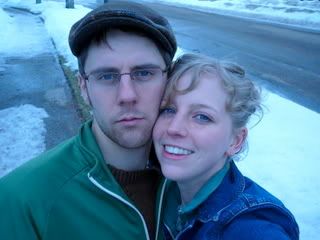
Well as Kaleigh says, Zak and I are "finally" engaged;)
Our day yesterday began with Zak calling me at what I thought was 9:15am - I was on a roll and I was actually going to be ON TIME for church for once, but no, Zak called me to say that we were already 15 minutes late for church. We had both forgotten about the time change for Daylight Savings! Part of the reason was that we were out enjoying ourselves at the Med Formal the night before:)
All morning Zak kept asking me what I wanted to do for the afternoon, we had both decided that we should take some time off and do something nice. It was quite funny, because there was something slightly awkward about how Zak kept asking me what I wanted to do and he's never awkward around me:) I guess he wanted me to think that our whole outing was my idea - but he knew what I wanted to do anyway and I knew what he was up to. I already told him a month or two ago that when he was to propose it would have to be outside and that we'd have to go for a hike - I just love to be outside - especially in Edmonton's River Valley.
So as we were getting ready to go for our hike Zak couldn't find his special hat that me and my parents gave him two Christmases ago. We called his friends and fortunately Nick remembered Zak putting it on the Grand Piano when we were at the Med Formal. We both know that that is a super special hat so any special pictures outside would not be complete without it (see the pictures - what good taste:).
So then we went to the Hotel downtown to pick it up and went on our way to one of the trails that starts just off Japser Ave. It was a fairly nice day and just a bit overcast. In Edmonton here, the snow is still melting - it stayed around from the WHOLE winter. Things were pretty slushy and Zak's shoes got soaked through.
We hiked and chatted for a while and then decided to go up some stairs so we could have an overview of the valley and just sit and relax on a bench. That is where Zak pulled a letter out of his pocket and then a little box:) Now you all know the rest.
Here we are at the top overlooking the valley. That's the Saskatchewan River behind us.
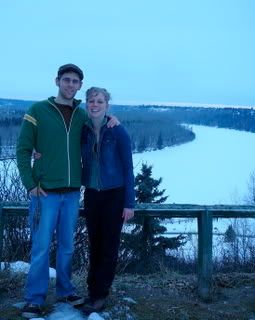
Here is the bench that we were sitting on - after we got up we noticed that it was in Celebration of someone's 50th Wedding anniversary:)
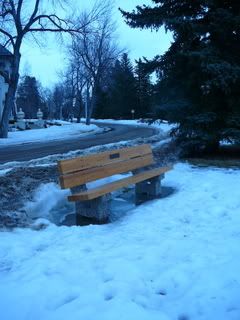
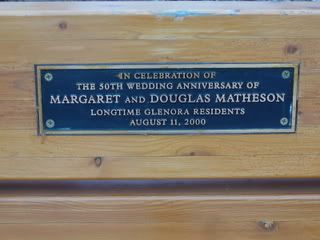
And yes, here's what the laides are waiting to see. Sorry for my mediochre photography skills. It's hard to take a picture of a diamond!

Wednesday, February 14, 2007
Rishi Tea - Fair Trade

I just made and exciting new discovery. I am a very avid tea drinker (along with Zak). I usually have about two pots a day - and it has to be loose leaf tea. That is the only way to drink it. It just tastes sooo much better. It can be like having a dessert. No need of sugar or milk - just enjoy the tea. It's like drinking wine. Every batch tastes slightly different.
To my dismay, I have only been able to locate three kinds of Fair Trade tea in Edmonton - Green Tea, Earl Grey Tea and Ceylon tea. Too bad they're all caffinated. I have issues with caffine, one pot of tea can make me dizzy and a little sick. So today I searched the net and discovered a brand called "Rishi Tea". They deal with premium tea and work directly with the tea growers and the creators of the tea flavours. They have ventured into Organic flavours and now they are starting to make Fair Trade varieties. They realized that an important part of working with the tea producers is sustaining the communities that grow the tea.
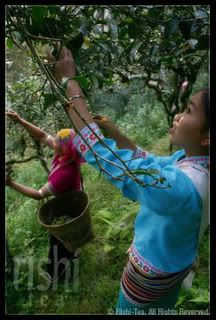
There is a community in south-western China that they work with. It is a very remote community and their whole community relies on the production of tea. It is a tradition that has been passed on in their community for over a 1000 years. The tea they grow is also deeply intertwined with their religion and every aspect of their lives. Here is a picture of one of the Fairly paid workers harvesting the tea on the organic farm.
The Rishi site gives detailed "Travelogues" of where they go to find the teas they sell. In a description of this Chinese community they describe the benefits of paying this community fair trade prices:
Social premiums generated by Rishi Tea sales of Jingmai Mangjing's tea have helped the local people to establish a library, a Bulang cultural center, an agricultural training program for villagers, road improvements and water purification. Recent Fair Trade premiums generated by Rishi's Ancient Tree Teas have supported the first two students from Mangjing Village to attend university, as well as the development of an herbal tea processing initiative to diversify cash crop biodiversity. Rishi's Fair Trade Ancient Tree Tea program encourages the conservation of the old tea trees by supporting the local hill tribes who are their natural protectors.

Fair Trade has enabled this community to survive and also to preserve their culture. Now that's some tea that I can feel good about drinking. Here is a picture of the cultural centre that the fair trade premiums helped them to build.
I will definitely be making most of my tea purchases from this company. Maybe one day I'll even start my own Fair Trade tea shop with them!!
Check out their website! They give a lot of information that's really interesting. http://www.rishi-tea.com/
Monday, February 05, 2007
Icons and the Eastern Church
As you probably know from my profile on my blog, I am a Religious Studies major. I always spend much time debating about what classes I am going to take each term. There is so much selection and so many interesting courses at the UofA. This term I signed up for a class called "Eastern Orthodoxy". I went to the first class and almost decided to drop it because I realized that it was going to be a lot of history.
I'm so glad that I stayed in the class. I'm actually enjoying all the history lessons. I've always been intrigued about who the Byzantines actually are and why doesn't Constantinople exist anymore or was it actually an imaginary place? Now I know and I can fit all the pieces together. The Eastern Church is left out of many Christian histories. I've learned about the reformation and about the branch off of all the Protestant churches, I've even learned more of the History of the Catholic church and the councils. While the Reformation was happening there was a separate development in the eastern world. I've been introduced to bits and pieces through reference in some books I've read, but I never really put it all together. I never learned where these people came from or what kind of environment they developed their view of God in.

I've become fascinated with their icons. They are so beautiful. This is an image of St. Searphim. He became a monk in 1793. He is one of the best known Russian monks/mystics. He lived a reclusive life and spent much time in the forest praying. This icon shows him kneeling on a rock praying and it is believed that he spent 1000 days and nights praying on this stone. He also was a very sought after spiritual director or as the Russians say a "Staretz". Many pilgrims sought after him for spiritual advice. These icons provide a visual reminder of admirable people who lived a life in devotion to God.
This is just one of the fascinating people that I get to learn about for my presentation on Wednesday. As much as I enjoy what the Professor brings up in class, I most enjoy the essay/presentation component of a course as I get to research what interests me most. I read and read and read . . . I love reading. I'm so glad that this presentation is at the beginning of the term so I have so much more time to read and learn about Russian Mysticism/Monasticism.
Here is another unique icon of the Virgin Mary with Jesus in her womb. I was looking through many icons and this provided the most interesting depiction of Mary and Jesus. It shows just how amazing it is that God came to earth through a human. He came to be one of us and yet still God. That is amazing that he loves us in that way. Icons help me to see these events that I've learned about in new and fresh ways.
Tuesday, January 30, 2007
Ethical Consumption
Today one of Zak's comments and my visit to Organic Roots prompted a train of thought as I was walking home from school. The other day Zak was commenting on whether or not it's worth it to get a Costco membership because since you get everything in bulk you just end up consuming more than you normally would and therefore, in the end, end up spending more than you normally would. Well this may be the case for some people and some products, not necessarily for all.

Well I went to Organic Roots today for some gluten-free granola bars and it seems to be the opposite of the whole Costco idea. They didn't even sell most of their granola bars in boxes, they were all sold individually which made me wonder how much more expensive it actually is to buy granola bars individually. My guess is that it's more expensive. I also bought some Fair Trade/Organic chocolate chips (yeah! I finally found them). I realize that anything Fair Trade and organic is more expensive than your average Hershey's Chipits.

Then you think about how in our Western culture we consume a lot! If all the worlds population consumed like we do there would be nothing left on the planet to make stuff out of. We buy things in super bulk packages, we get every single cup of coffee in a throw away cup, we get a NEW bag for almost every single item that we buy (not just groceries but in the Mall too), we are hard on our clothes and throw them out after a year or two and think it's so easy just to get new ones, we buy excess food and just throw it out if it goes bad and it goes on and on.
What if we actually had to pay more for all of these things that we routinely use? Like my Fair trade/organic chocolate chips, yes they cost more, but because of that I will use them more wisely and not over eat the special chocolate chip cookies that I make with them. What if everything was sold in smaller portions rather than in massive quantities? We would actually think about how much we actually need rather than getting so much more than we need. I think that an important element of Fair Trade and Organic products is that we actually think of what we're buying and how much we're buying.
Sure, I think that it's very ethical to pay people on the other side of the world fair prices and grow organic produce to help the environment. But buying fair trade and organic makes the consumer think of other things too. It forces a person to focus on the day to day and not get sucked into the massive consumerism of our society and to only consume what is needed. In this way we can individually contribute to minimizing the massive ecological footprint that we in the West make in the world. We need to use our resources wisely and realize that we have soooo much more than we need.

Well I went to Organic Roots today for some gluten-free granola bars and it seems to be the opposite of the whole Costco idea. They didn't even sell most of their granola bars in boxes, they were all sold individually which made me wonder how much more expensive it actually is to buy granola bars individually. My guess is that it's more expensive. I also bought some Fair Trade/Organic chocolate chips (yeah! I finally found them). I realize that anything Fair Trade and organic is more expensive than your average Hershey's Chipits.

Then you think about how in our Western culture we consume a lot! If all the worlds population consumed like we do there would be nothing left on the planet to make stuff out of. We buy things in super bulk packages, we get every single cup of coffee in a throw away cup, we get a NEW bag for almost every single item that we buy (not just groceries but in the Mall too), we are hard on our clothes and throw them out after a year or two and think it's so easy just to get new ones, we buy excess food and just throw it out if it goes bad and it goes on and on.
What if we actually had to pay more for all of these things that we routinely use? Like my Fair trade/organic chocolate chips, yes they cost more, but because of that I will use them more wisely and not over eat the special chocolate chip cookies that I make with them. What if everything was sold in smaller portions rather than in massive quantities? We would actually think about how much we actually need rather than getting so much more than we need. I think that an important element of Fair Trade and Organic products is that we actually think of what we're buying and how much we're buying.
Sure, I think that it's very ethical to pay people on the other side of the world fair prices and grow organic produce to help the environment. But buying fair trade and organic makes the consumer think of other things too. It forces a person to focus on the day to day and not get sucked into the massive consumerism of our society and to only consume what is needed. In this way we can individually contribute to minimizing the massive ecological footprint that we in the West make in the world. We need to use our resources wisely and realize that we have soooo much more than we need.
Sunday, January 21, 2007
Soapstone Carvers: Tara Projects, New Delhi, India
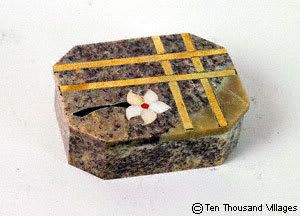
This month at our Ten Thousand Villages store in Edmonton we will be featuring the Soapstone Carvers from India in our Valentines display. They have created some beautiful hearshaped boxes from soapstone that are inlayed with mother of pearl and other semi-precious stones. Pictured above is the rectangular shaped box that is similar to the heart shaped box.
Soapstone is a soft stone with a smooth soapy feel and the true colour isn't visible until they carvers have finished and polished it off. One small box can take up to twelve hours to complete.
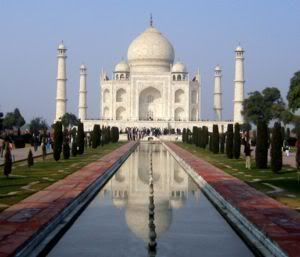
Many centuries ago, when the Taj Mahal was being built, many soapstone carvers were recruited from Persia to work on the intricate carving on the building. The descendnets of these people still live in India today where they continue the tradition of working with soapstone and creating intricate inlayed designs. Despite the beauty and detail of their work, soapstone carvers have been exploited and many of them live in poverty. Many of them live in conditions around open sewers and drains.
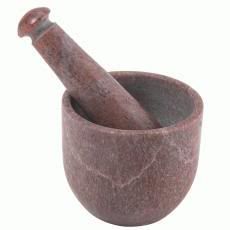
Tara Projects began to work with stonecarvers in the early 1990s and they pay these stone carvers a fair wage. They have created pension plans for the elderly, they provide much needed medical care, and they even fixed the drains and sewers. Tara projects provides work for about 250 stonecraft artisan families.
Tara Projects began working in New Delhi in the early 1970s. The project was established by social workers and University students to help the "untouchables" in their area. Ten Thousand Villages Literature describes how "This organization has become a leading voice opposing the use of child labour, and promoting the rights and status of women". Some of the services they provide to their workers includes informal education for womena and children and training in health and environmental awareness.
Please check out the link on the left hand side of my website called the "TTV Mumbai Marathon Trip". There is a group that has gone to India to visit the various artisan projects there. They should be going to visit Tara Projects later this week - so I'm sure they'll have more pictures up from that soon. Their pics will definitely provide more insight than mine. Some of them also just did the Mumbai 1/2 marathon today to raise awareness for Ten Thousand Villages and Fair Trade!! Congratuations to all of them.
Saturday, January 13, 2007
Artisan Story: Kommaly Chanthavong - Phon Tong Handicraft, Laos
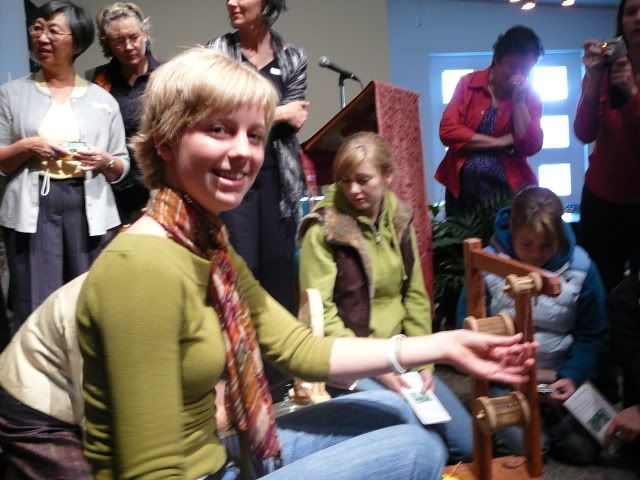
If you want to know where my passion is, it's Ten Thousand Villages. There is so much behind what you see when you go into the store. There are so many stories behind each product. There are SO many people who live better lives because of the store - it especially helps women who could not otherwise provide for themselves. Much of the time these women in developing countries do not have employable skills and they are not given a chance in the working world. Ten Thousand Villages partners with MCC and other organizations, which help women and other disadvantaged people groups develop skills so that they can make a living for themselves.
One amazing example of a woman with a vision is Kommaly Chanthavong. I had the pleasure of meeting her and hearing her story in Calgary in October. She lives in Northern Laos where she fled to as a refugee. Many of the women there were in the same situation as her and were in great need of work. Most of the women including Kommaly had learned silkwork from their mothers as girls don't go to school. Kommaly decided to use these skills and began her business with ten other women who decided to create silk scarves with her to sell. Now the group has expanded to more than 450 people in 35 villages. Here is a picture of Kommaly teaching us the Silk making process.

One of the exciting aspects of her business is that it is completely self sustainable. She works with the farmers who raise cattle and uses the manure to fertilize the mulberry trees which feed the silk worms. The mulberry trees are also used to make tea, which Kommaly has also found a market for. I tried it and it was quite good. Keep your eye's peeled for Organic Mulberry tea. All material from the silk making process that would normally be considered waste is used, including the larvae which are in the cocoons which the silk comes off of. The larvae are a good source of protein. The water that the larvae are boiled in is also very good for the skin - as witnessed by Kommaly's beautiful skin:) You can see the larvae in the picture below.

The cocoons are boiled and the cocoons becomes very sticky. All of the larvae stick together and one very thin and very long thread (see me holding it in the picture at the top of this post) is spun out of the the larvae that are in the pot. Below you can see one of the guys at the workshop spinning the thread.

As mentioned above, nothing is wasted in the silk making process. The berries from the mulberry tree are also used to dye the threads. All of the dyes are from natural elements.
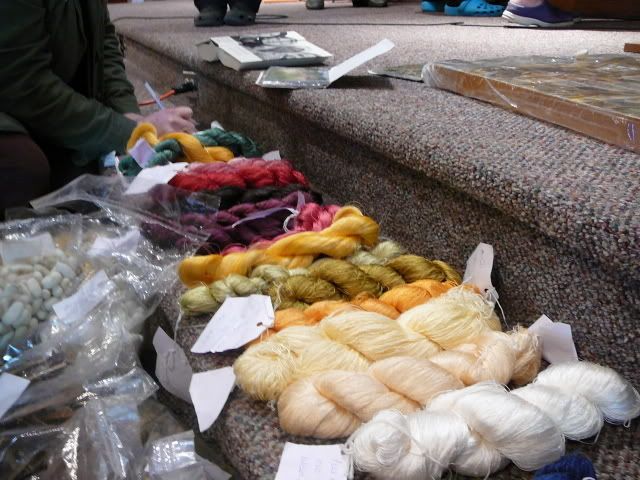
Kommaly and the women who work with her have been very successful with their business and sell their Scarves to Ten Thousand Villages as well as buyers in other countries. Many of their scarves have won awards in various competitions.
I hope that you've enjoyed this bit of information. I think that it makes an item so much more valuable when you know the person that is behind it and how much it has helped them. So, keep this in mind when you see a silk scarf from Laos!
Subscribe to:
Posts (Atom)
